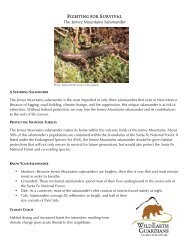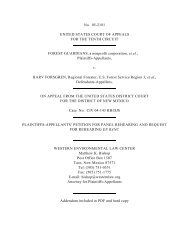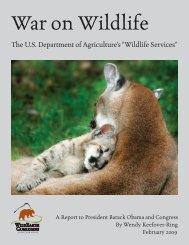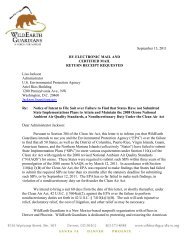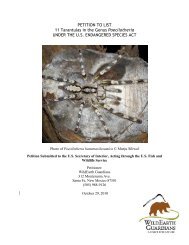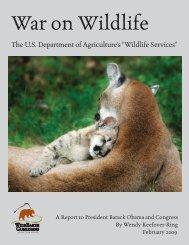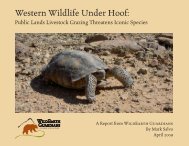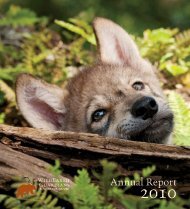PETITION TO LIST THE JEMEZ MOUNTAINS SALAMANDER ...
PETITION TO LIST THE JEMEZ MOUNTAINS SALAMANDER ...
PETITION TO LIST THE JEMEZ MOUNTAINS SALAMANDER ...
You also want an ePaper? Increase the reach of your titles
YUMPU automatically turns print PDFs into web optimized ePapers that Google loves.
WildEarth Guardians Petition to List<br />
Jemez Mountains Salamander Under the ESA<br />
23<br />
Loss of habitat and population viability due to fire<br />
The Jemez Mountains salamander has persisted through significant changes in climate<br />
and vegetation and is best adapted to conditions characteristic of older, mature forests.<br />
During the last century, direct and indirect fire suppression has resulted in unnatural and<br />
excessive fuel loads which have increased the risk of fire in this salamander’s habitat<br />
(NMEST 2000b). Although the Jemez Mountains salamander has endured natural<br />
wildfires, current conditions pose a great risk as large, intense, stand-replacing wildfires<br />
are now common. These fires can and do greatly alter substantial areas of Jemez<br />
Mountains salamander habitat. The CMP states that, “Currently, the greatest threat to<br />
this species is thought to be the potential for extensive stand-replacing fires (NMEST<br />
2000b).”<br />
Effects of stand-replacing fires are measured in the severity of burn. Low-intensity fires<br />
result in the removal of all or part of the duff layer with little effect to the grasses, forbs,<br />
shrubs and trees. Low to moderate burn intensity areas have 1,000 hours of fuels<br />
remaining on the ground and live tree canopies overhead (BAER 2000). In moderate<br />
burn intensity areas, the fire kills between 10-70% of vegetation and areas of high burn<br />
intensity experience 90-100% mortality of all vegetation.<br />
High-severity burns negatively affect salamander populations in a variety of ways. Prey<br />
species richness, diversity and abundance are lost during high-severity burns and<br />
populations of prey species may take anywhere from five to ten years to recover<br />
(McCullough et al. 1998; Malmström 2006). Salamanders are poikilothermic and depend<br />
on environmental conditions to regulate body temperature. High-severity surface fires<br />
and crown-burning fires increase soil temperature. Such fires reduce litter depth and<br />
remove canopy cover. This results in an increased duration of high soil temperatures<br />
(NMEST 2000b; Everrett 2003). The soil temperature of high-severity burn sites often<br />
exceeds the “critical thermal maximum” of 33.5 C, as described by Whitford (1968), for<br />
the Petitioned species (Cummer 2003). A high-severity burn impacts a variety of soil<br />
physical and chemical properties that affect the salamander’s microhabitat, including the<br />
loss or reduction of structure and soil organic matter, reduced soil porosity, and increased<br />
soil pH. These changes also result in various indirect impacts, one of which is increased<br />
hydrophobicity (water repellency). The consequence of this is decreased water<br />
infiltration and therefore a decrease in moisture available to the salamander in its<br />
underground habitat (Bruhjell and Tegart 2001). As stated above, the Jemez Mountains<br />
salamander relies on a moist environment for cutaneous respiration. These<br />
environmental changes, especially those that tend towards dryness, can cause mortality<br />
(Williams 1972).<br />
Since 1996, three large, intense, stand-replacing fires have occurred in Jemez Mountains<br />
salamander habitat (Table 3) (Figure 4). A total of 18,783 acres burned with high<br />
intensity. The Burned Area Emergency Rehabilitation Team (BAER) stated that, “Due to<br />
the severe habitat degradation resulting from the Cerro Grande Fire, Jemez Mountains<br />
salamanders may not survive in these areas. The areas of high fire intensity and<br />
vegetation mortality will likely be unsuitable salamander habitat for many decades”



